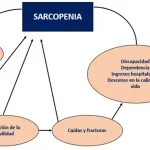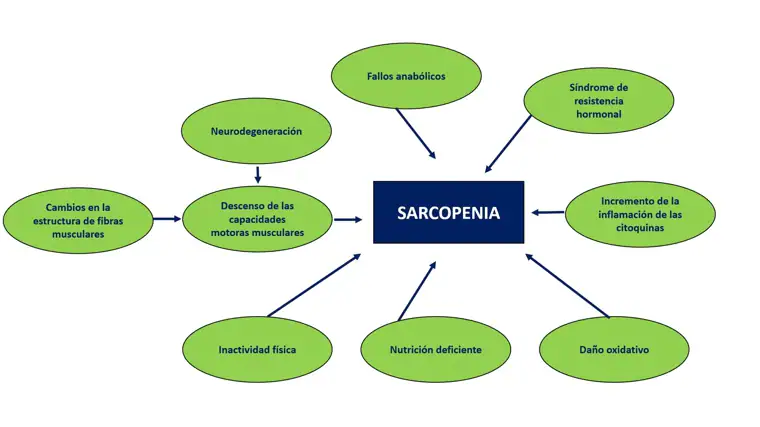

The new generations are growing up with an enormous amount of information about the benefits of physical exercise. Even so, it seems that things are not going well, but that is another matter. However, among older people, the general idea continues to prevail that there is a stage in sports, which ends approximately when we enter the labor market, after which anyone who dedicates time to ‘the gym thing’ is someone without a job or benefit or , even, that borders on intellectual limitation. To close this absurd line of thought, if it can be called that, it is worth the fact that our Nobel Prize winner Don Ramón y Cajal He was one of the many scientists who loved sports and, in his case, bodybuilding.
The correlation between mortality and loss of muscle mass and functionality is an important issue in health, especially in older adult populations, where there are some key points to consider:
Sarcopenia and dynapenia
The first refers to the loss of muscle mass, although medically it is a relatively young term (it was proposed in 1989 by Irwin Rosenberg), who more or less has already heard of it. The dynapenia It is the loss of our ability to exert force, hence they are closely related although not necessarily proportional.

In any case, both are associated with a greater risk of falls, fractures and disability. The impact that they can have when it comes to limiting the ability to carry out daily activities is closely correlated with a higher mortality rate since, in addition, it represents an increase in comorbidities such as cardiovascular diseases, diabetes and unfavorable metabolic conditions.
The lack of physical activity in older people, decreased appetite, malnutrition associated with chronic calorie deficit (which exacerbates the loss of muscle mass) and increasingly longer recoveries, even from minor illnesses, create the ideal breeding ground for skyrocket mortality rate from 65 years of age among those with fragile muscle health.
Sufficient nutrition as well as prescribed physical exercise in adequate quantity and intensity are the two best possible interventions and, sorry, walking is not enough.
I don’t exercise except walking. How much muscle mass am I losing?
Starting at age 40, it is estimated that people can lose approximately 1% to 2% of their muscle mass per year if no interventions are performed. These figures can mean that for the 70 – 80 years we have lost between 30% and 50% of our total muscle mass.
If this may not seem serious given that we think that at this point in life it is not a time for exercise, but for rest and rest, perhaps we can understand the magnitude of the problem by reviewing the impact it has on the health system: a study carried out in the United States estimated that the direct costs related to the sarcopenia reached approximately $18.5 billion in 2000. This cost includes expenses for hospitalizations, medical care and long-term care as it plays a crucial role in the development of frailty, which translates into an increased risk of falls. , fractures and disability.
These are not assumptions, this is not sensational information. There is an immense amount of research that demonstrates this data. Here are some examples:
• Older adults with sarcopenia have a significantly increased risk of fallswhich in turn results in an increase in hospitalizations due to fractures and fall-related injuries ( Cameron, JD et al. (2018). “Sarcopenia and its association with falls and hospitalizations in older adults.” Journal of the American Geriatrics Society.
• Older patients with sarcopenia have worse outcomes in terms of length of hospital stay and complication rates compared to those without sarcopenia (Nakamura, R., et al. (2019). “Impact of sarcopenia on hospital outcomes in older patients with pneumonia.” BMC Geriatrics.
• Sarcopenia is associated with a increased risk of hospital readmission in the elderly, suggesting that loss of muscle mass and function contributes to health complications that require additional medical attention (Bhandari, M. et al. (2020), “Sarcopenia and its association with hospital readmission in older adults”. Geriatrics & Gerontology International.
• Older patients with sarcopenia have a higher risk of complications and mortality associated with respiratory infectionsincluding pneumonia (Cruz-Jentoft, AJ, et al. (2019). “Sarcopenia: A critical appraisal”. European Geriatric Medicine.
• The elderly with better muscle mass and nutritional status tend to have better health outcomes and a greater ability to cope with common illnesses, suggesting a link between muscle mass and recovery from mild infections (Fried, LP et al. (2001), “Frailty in older adults: evidence for a phenotype.” Journals of Gerontology Series A: Biological Sciences and Medical Sciences) .
• Individuals with sarcopenia may experience a slower and less effective recovery of common diseases due to a lower functional reserve. This implies that those who have better muscle mass could better manage diseases such as colds (Kumar, V., et al. (2016). “Sarcopenia and frailty: the role of exercise.” Journal of Aging Research).
• This study of group comparison analyzed how sarcopenia affects recovery and clinical outcomes in older adults. The results suggest that those with sarcopenia have a higher risk of complications and a longer recovery from infections (Miller, RA, et al. (2013). “Sarcopenia and its relationship with clinical outcomes in older adults.” Journal of the American Geriatrics Society).
Muscles against Alzheimer’s and Parkinson’s
Alzheimer’s, like other neurodegenerative diseases, is still a mystery, but some relevant findings in scientific research suggest that maintaining good muscle health can have positive effects in the prevention of these diseases thanks to certain biological mechanisms:
• Inflammation: Proper muscle health can help regulate inflammation in the body. Chronic inflammation has been linked to the development of neurodegenerative diseases such as Alzheimer’s and Parkinson’s, and exercise may act as a modulator of this inflammation.
• Neurotrophic Factors: Exercise promotes the release of neurotrophic factors, such as BDNF, which are essential for neuronal health and may protect against neurodegeneration.
It is worth remembering that the movement of our muscles is the final mechanical consequence of a neuronal order that comes from our brain. When a person has a severe period of inactivity, their first steps in rehabilitation are to regain the ability to recruit muscle fibers. What is not used atrophies. Although it may not seem like it, physically demanding ourselves is ‘forcing’ our central nervous system to be ‘active’, to continue sending electrical impulses that connect/activate/coordinate our body. So now you know, in addition to good shoes, add some weights and strength training that challenges your abilities whatever they may be.